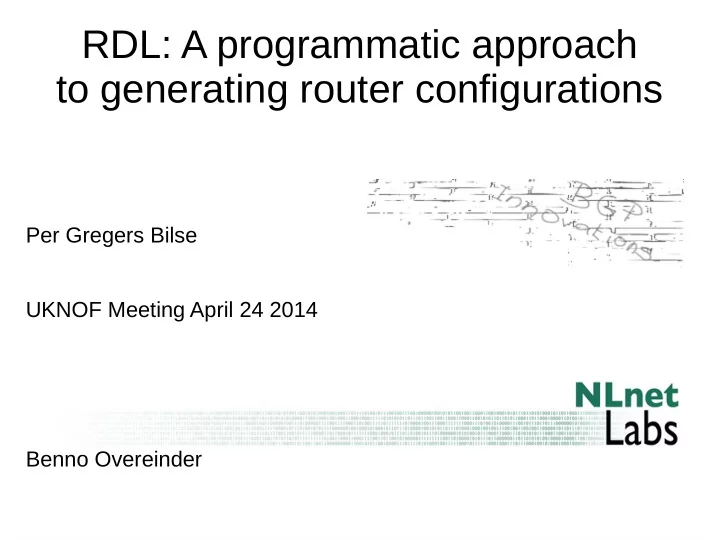

RDL: A programmatic approach to generating router configurations Per Gregers Bilse UKNOF Meeting April 24 2014 Benno Overeinder
RDL: The background ● ENGRIT: Extensible Next Generation Routing Information Toolset ● Improve Internet routing security and stability ● Multi-pronged approach, RDL is one aspect ● Other aspects will focus on authentication, etc ● NLnetLabs has done much work with DNS
RDL: The rationale ● Global turnover $dozens of millions per hour ● Even small problems can be very costly ● Router configuration is inherently low level ● Large number of only moderately related detail ● Limited or no verification tools ● Limited scope for inter-ISP routing management
RDL: The idea ● A high level Routing Documentation Language ● Dual purpose: ● 1) Architecture independent generation of BGP config: – RDL->Cisco, RDL->Juniper, RDL->BIRD – C->68k, C->x86_64, C->ARM ● 2) Description and publication of routing policies: – Enable automated verification and proofing – Improve exchange of information between peers
RDL: Not RPSL NG NG ● RDL intended to reuse parts of RPSL: – Some objects – Publication/repository means, where feasible ● But, more importantly: – RDL to describe BGP topology – RDL to cover both iBGP and eBGP peerings – RDL to fully qualify and identify routing policies
RDL: What is a policy? ● Much confusion between Policy and Enforcement Action ● A policy is Thieves will be prosecuted ● An enforcement action is Arrest Nosey Parker ● Existing tools and approaches focus on enforcement actions ● Quickly degenerate into route filter mechanics
RDL: Policies in 3D ● A routing policy as seen by RDL has three dimensions to it: – Where it applies: topological location – When it applies: NLRI attributes – What to do: filtering and attribute manipulation ● Think of it as similar to a piece of legislation, eg speed limits: Where, When, What ● These three aspects jointly describe a given policy in its entirety
RDL: A policy example ● Policy: My AS will not announce bogons ● RDL's 3D approach: – Where: all peerings with foreign ASs – When: prefix is in list of bogons – What: block it ● RDL's BGP topology description is the key to specifying the Where of a policy ● the Where is statically analysed and applied when generating configurations ● The When and the What are done by the routers
RDL: The language ● Designed specifically for the purpose of describing BGP topologies simply and intuitively ● Free form curly brace, recursive, and concatenative syntax, allowing quick and easy specification of objects and their location ● Borrows inadvertently and disrespectfully from several unusual languages ● Fully dynamically typed and declaration free
RDL: BGP topology ● RDL describes BGP topology by way of three objects: – Zones – may contain other zones, and routers – Routers – may contain one or more BGP peers – Peers ● Structure similar to file system directories ● Each object has a number of attributes ● Attributes may be inherited from lexical scope
RDL: Topology example hibernia = new(zone) . { asn = 5580; EU = new(zone) . { NL = new(zone) . { ams1 = new(router) . { address = 134.222.1.1; ripe = new(peer) . { 1.2.3.4, 3333 }; }; }; }; US = new(zone) . { .... }; APAC = new(zone) . { ... }; };
RDL: What's in a zone ● Zones are containers for similar policies – often significant geographical correlation – should be chosen to reflect the reality of your network, not the other way around (your network is the ground, the zone map is the map) – you decide what your zone map should be, it is there to help you – again: RDL is all about BGP topology – the zone map identifies reference points for policies
RDL: Policy example ● Policy descriptions follow the topology format nobogons = new(policy) . { where = export peer.asn != peer.router.asn; when = nlri.prefix & bogons; what = reject; }; bogons = { 0.0.0.0/8^+, 10.0.0.0/8^+, 100.64.0.0/10^+, ... }; ● Policy syntax is experimental/undecided ● Probably a good idea to stick to general syntax of RDL
RDL: Unusual Example I hibernia = new(zone) . { asn = 5580; RR1 = new(router) . { 134.222.12.1, RR }; EU = new(zone) . { ibgp = { RR1, localmesh }; NL = new(zone) . { ams1 = new(router) . { 134.222.1.1 } . { ... }; }; }; US = new(zone) . { ibgp = { RR1, localmesh }; ... }; };
RDL: Unusual Example II ● Policy: de-prioritise all EU routes in US ● RDL to the rescue: EUexport = new(policy) . { where = import peer.zone <= US && peer.remote.zone <= EU; when = ; what = local-preference = 90; }; ● Because RR1 is a route reflector it is transparent
RDL: Unusual Example III Changing iBGP to full mesh requires only a few edits: hibernia = new(zone) . { asn = 5580; RR1 = new(router) . { 134.222.12.1, RR }; EU = new(zone) . { ibgp = { RR1, localmesh }; NL = new(zone) . { ams1 = new(router) . { 134.222.1.1 } . { ... }; }; }; US = new(zone) . { ibgp = { RR1, localmesh }; ... }; };
RDL: Nirvana? RDL is all about not configuring routers , but programming the AS . ENGRIT + admin: benno@nlnetlabs.nl RDL: pgb@bgpinnovations.com
Recommend
More recommend